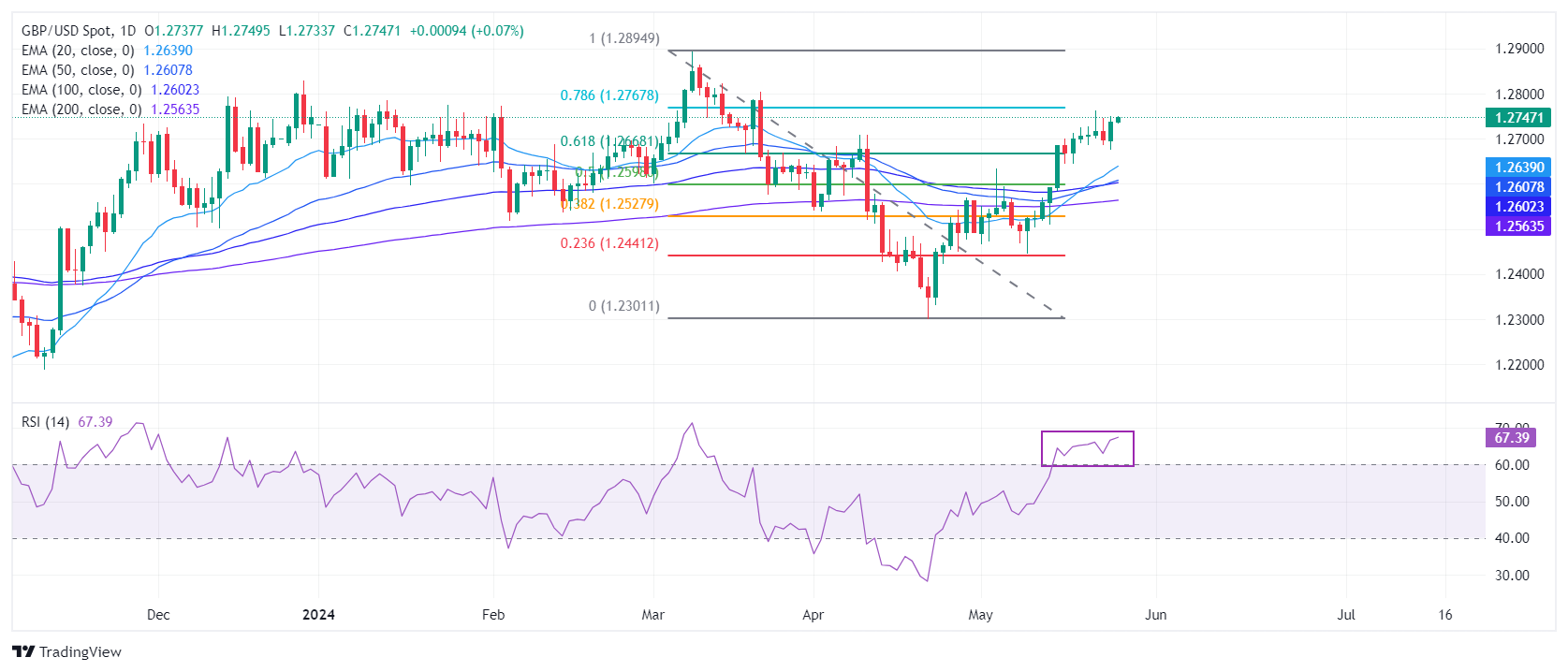Pound Sterling jumps to weekly high amid uncertainty over BoE rate cuts

- The Pound Sterling moves higher as the US Dollar drops even though Fed rate-cut bets ease.
- Improved US economic outlook has weighed on Fed rate-cut prospects for September.
- UK Retail Sales and preliminary PMI weaken due to BoE’s restrictive interest rate policy.
The Pound Sterling (GBP) rises to near 1.2750 against the US Dollar (USD) in Monday’s London trading session. The GBP/USD pair remains firm as bets supporting the Bank of England (BoE) reducing interest rates from the June meeting have diminished due to a slower-than-expected decline in the United Kingdom’s (UK) consumer inflation for April.
Economists forecasted that the UK headline inflation would fall to 2.1% year-over-year in April but slowed to 2.3% from the previous reading of 3.2%. Also, a nominal decline in the UK service inflation deepens fears of inflation remaining persistent for a longer period. The UK service inflation slowed slightly to 5.9% from the prior reading of 6.0%. UK’s sticky service inflation has remained a major barrier to price pressures returning to the objective rate of 2%.
However, other economic indicators, such as Retail Sales and the preliminary Purchasing Managers’ Index (PMI) report for May, suggest that the UK economy struggles to absorb the consequences of higher BoE interest rates. Retail Sales declined significantly as rainfall reduced consumer footfall at retail stores. May’s S&P Global/CIPS Composite PMI was dragged down due to a sharp decline in demand in the service sector.
Daily digest market movers: Pound Sterling strengthens as traders pare BoE rate-cut bets
- The Pound Sterling remains firm against the US Dollar in a thin-volume trading session due to holidays in the United Kingdom (UK) and the United States (US) markets on account of the Spring Bank Holiday and Memorial Day, respectively. Though trading activity is expected to remain quiet, any surprise move due to the occurrence of a global event could spur a sharp directional move as fewer market participants would struggle to absorb unexpected orders.
- The near-term outlook of the GBP/USD pair remains firm as the US Dollar is under pressure despite traders paring bets supporting interest rate cuts by the Federal Reserve (Fed) from their current levels in the September meeting. The CME FedWatch tool shows that the probability for rate cuts in September has reduced to 49% from 63% recorded a week ago, suggesting that investors’ confidence in Fed rate cuts has been pushed to the November meeting.
- Market speculation about the Fed lowering interest rates from September has eased as policymakers have been maintaining hawkish guidance on interest rates and an improvement in the US economic outlook. Fed officials want to see inflation declining for months to be sure that it will return to the desired rate of 2%. Officials are less convinced that the slowdown in inflation in April will last long.
- Given the strength of the US labor market, Fed officials believe that they can maintain the current interest rate framework for a longer period. Meanwhile, the surprisingly upbeat preliminary US PMI report for May has also exhibited a firm picture of economic prospects.
- This week, market speculation for Fed rate cuts will be significantly influenced by the core Personal Consumption Expenditure price index (PCE) data for April, which will be published on Friday. A slowdown in April’s Consumer Price Index (CPI) after a hot first quarter suggests that core PCE inflation figures could also remain soft from prior readings.
Technical Analysis: Pound Sterling holds above 61.8% Fibo retracement
Pound Sterling trades close to Friday’s high around 1.2750. The GBP/USD pair is likely to extend upside above the weekly high near 1.2760 as the outlook is bullish. The appeal for the Cable remains high as it has established a firm footing above the 61.8% Fibonacci retracement (plotted from the March 8 high of 1.2900 to the April 22 low at 1.2300) at 1.2667.
The Cable is expected to remain in the bullish trajectory as all short-to-long-term Exponential Moving Averages (EMAs) are sloping higher, suggesting a strong uptrend.
The 14-period Relative Strength Index (RSI) has shifted into the bullish range of 60.00-80.00, suggesting that the momentum has leaned toward the upside.
Economic Indicator
Core Personal Consumption Expenditures – Price Index (YoY)
The Core Personal Consumption Expenditures (PCE), released by the US Bureau of Economic Analysis on a monthly basis, measures the changes in the prices of goods and services purchased by consumers in the United States (US). The PCE Price Index is also the Federal Reserve’s (Fed) preferred gauge of inflation. The YoY reading compares the prices of goods in the reference month to the same month a year earlier. The core reading excludes the so-called more volatile food and energy components to give a more accurate measurement of price pressures.” Generally, a high reading is bullish for the US Dollar (USD), while a low reading is bearish.
